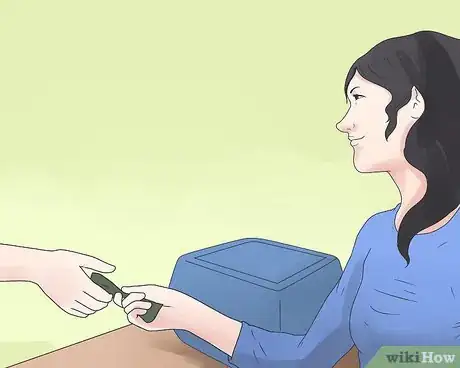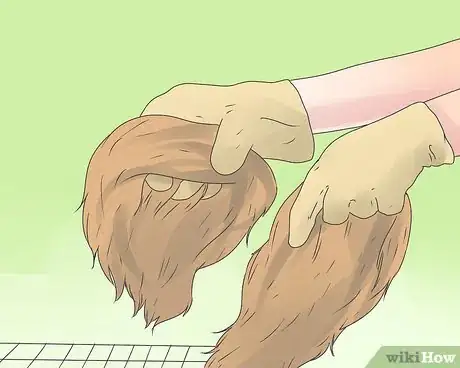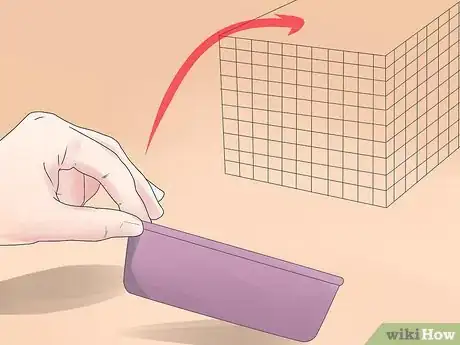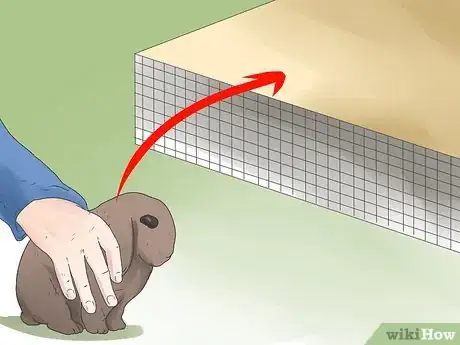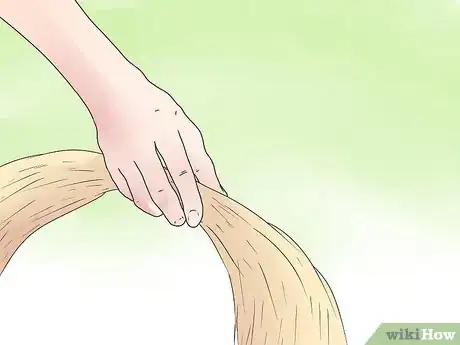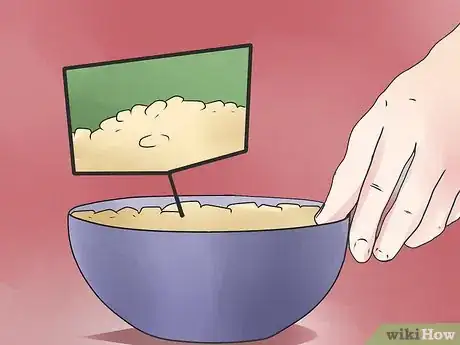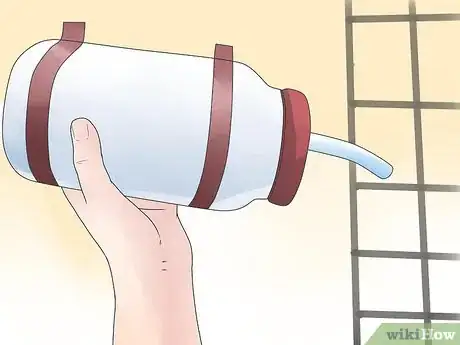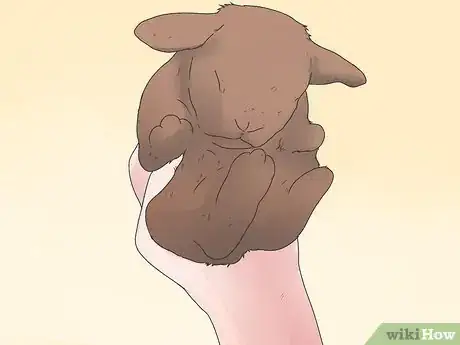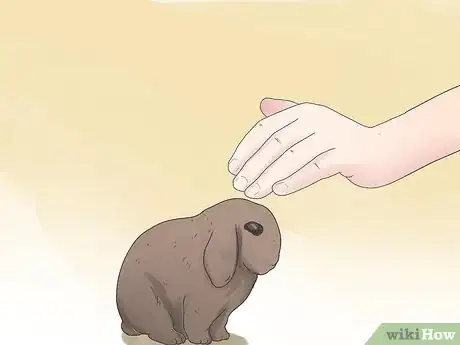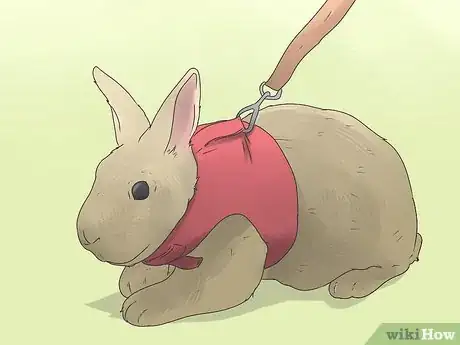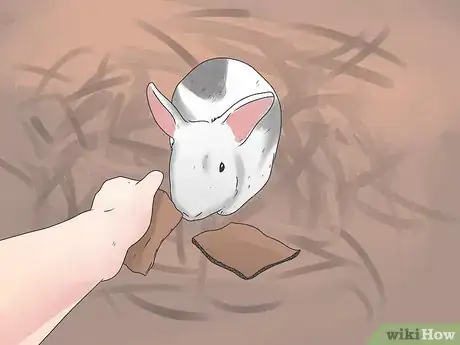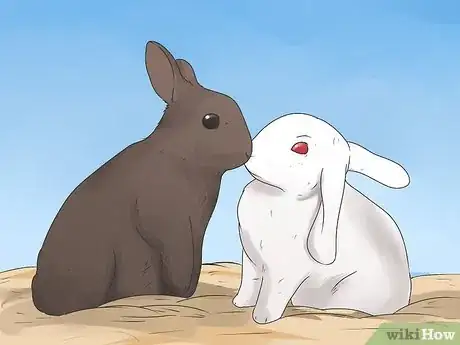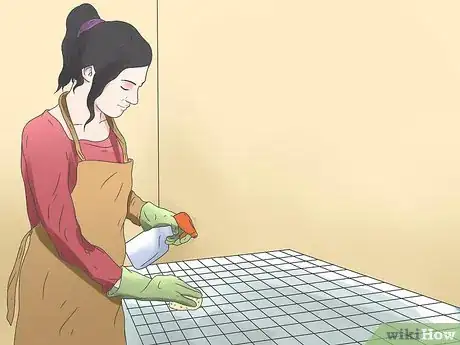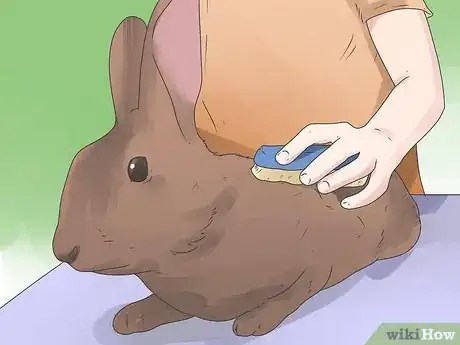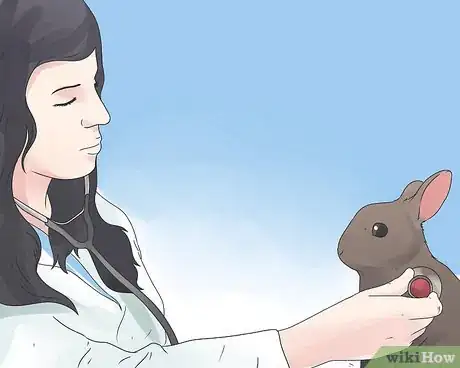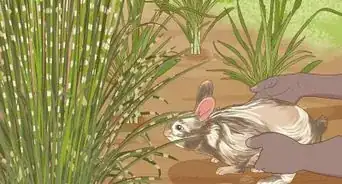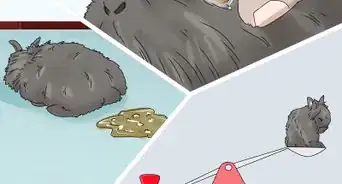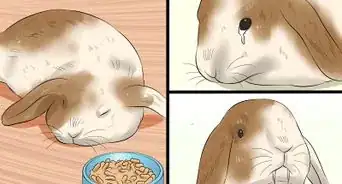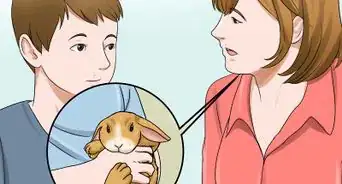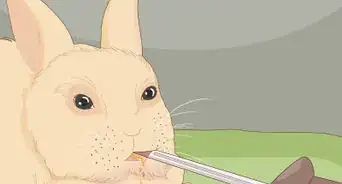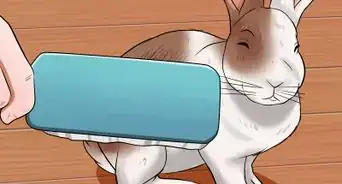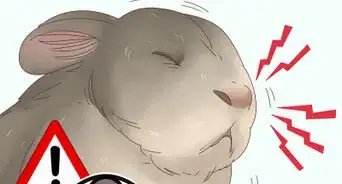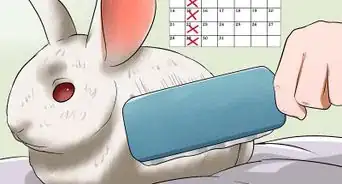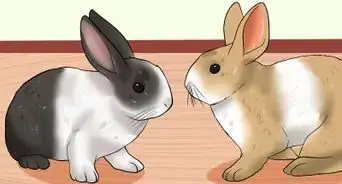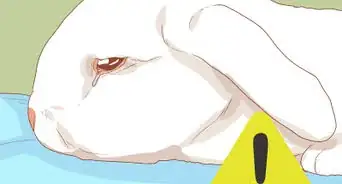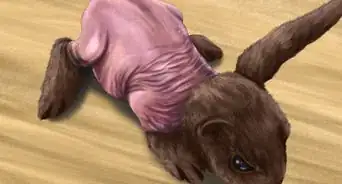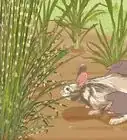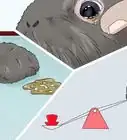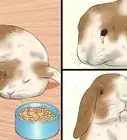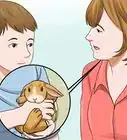This article was co-authored by Melissa Nelson, DVM, PhD. Dr. Nelson is a Veterinarian who specializes in Companion and Large Animal Medicine in Minnesota, where she has over 18 years of experience as a veterinarian in a rural clinic. She received her Doctor of Veterinary Medicine from the University of Minnesota in 1998.
wikiHow marks an article as reader-approved once it receives enough positive feedback. This article received 33 testimonials and 96% of readers who voted found it helpful, earning it our reader-approved status.
This article has been viewed 388,971 times.
Mini lop rabbits are known for their sweet nature and hardy constitution, qualities that make them excellent pets. Mini lops, like all rabbits, need a clean hutch, a nutritious diet, and gentle handling in order to thrive and be happy.
Steps
Providing Shelter and Food
-
1Buy a rabbit cage or hutch. Mini lops are small creatures, but they like to have plenty of space to hop around. Look for a large rabbit playpen or consider free roaming your rabbit. The minimum dimensions of your enclosure should be 3–4 feet (0.9–1.2 m) wide, 2 feet (0.6 m) deep and about 3 feet (0.9 m) high.[1] The sides should be made of wire, not glass, because the bunny will need plenty of fresh air to flow through the cage. Make sure not to use a wire bottom cage as the rabbits are at high risk of sores on their feet. [2]
- If you decide to go with an outdoor hutch, place it in a shady spot so that the rabbit doesn't overheat during the summer. You might need to heat the hutch during winter if the temperature drops low. It's also important to keep potential predators away. Foxes, dogs, cats, and birds of prey are all quite dangerous to a rabbit.
-
2Line the cage with soft material. This way your rabbit will be able to build a soft, cozy, nest.Advertisement
-
3Use only hay that is approved for use in a bunny cage. Never use old hay or hay from a source you don't know and trust, and never use pine or cedar wood shavings. The fumes can hurt rabbits' internal organs.
-
4Place a litter box in the cage. If you place a large litter box in the mini lop's cage, he will relieve himself in that same spot instead of going elsewhere, making cleanup much easier. However, some rabbits may need to be trained. You can find a cat litter box at pet stores. Line the litter box with newspaper or a puppy pad. then place a small amount of litter on top. fill the litter box to the brim with hay as this is the main part of a rabbits diet and they like to eat whilst they go to the bathroom.
-
5Rabbit-proof rooms where your rabbit will live or come out to play. Many owners of mini lops like to take their rabbits out to play. make sure you rabbits space has been thoroughly "rabbit-proofed" so that the mini lop won't get hurt. Remove electrical cords and wires/ purchase a cord protector. remove fragile or heavy items that could fall over, and other items you don't want to be nibbled.
-
6Provide unlimited hay. Rabbits both nest in and eat loads of hay, so you should put lots of fresh hay in the cage every day. Timothy hay and brome hay are good choices for rabbit feed. There's no need to set the hay in a dish; just sprinkle it all around the cage. if your rabbit is below 6 months feed alfalfa hay.[3]
-
7Set out a dish of vegetables and add a small amount of pellets depending on the weight of your rabbit.. Rabbit pellets contain essential nutrients like protein and fiber. When your mini lop is still a baby, give it more pellets. Adult mini lops can get 1/8 cup of pellets for every 5 pounds of body weight. Throughout the rabbit's life, provide fresh vegetables to enhance its diet. 2 cups a day of spinach, collard greens, and turnip greens are the best choice, but you can also feed your rabbit the occasional carrot.
- You can also feed your rabbit a small amount of fruit, such as cut-up apples, bananas, and strawberries.
- Do not feed your rabbit the following vegetables, which can hurt its stomach: corn, tomatoes, cabbage, iceberg lettuce, potatoes, peas, onions, beets, and rhubarb.
- Never feed your rabbit the following foods: seeds, grains, meat, chocolate, dairy, and any other "human" food/treats.
-
8Provide rabbit chews. Rabbits' teeth grow continuously throughout their lives, and it's important to provide them with something to chew on so they won't get long and uncomfortable. You can buy rabbit chews at the pet store, and give your rabbit a new one every week or so.
-
9Place a water bowl in the cage. Rabbits need access to plenty of clean water. Buy a ceramic bowl so your rabbit will not toss it about. They need to drink as much as a full-sized dog. Make sure you change the water every day and clean out the dish frequently.
Handling and Playing With Mini Lops
-
1Pick up the mini lop gently. When you're handling a rabbit, the first rule to remember is that you should never pick one up by the ears or scruff. A rabbit's ears are fragile and sensitive, and this could cause permanent damage. Instead, place one hand under his rear area and the other between his front legs. Bring the rabbit close to your chest and hold him there securely. When you're ready to put him down, crouch down and gently rest him on the floor.only do this. when necessary as rabbits are animals of pray and most don't enjoy being picked up.
- Do not drop your rabbit or let him jump to the floor from your arms. The impact could hurt his legs.
- Do not lift your rabbit from the scruff of his neck. Rabbits don't have extra skin there as cats do.
-
2Pet your mini lop carefully. Mini lops are pretty sturdy as far as rabbits go, but they don't like being handled roughly. Pat your mini lop gently on the head and cheeks. if your rabbit is timid approach it from the side where they can see. Never toss him, push him or pull him by the legs, ears or tail. If your bunny is afraid, don't force him to play.
-
3Give your mini lop plenty of exercise. Rabbits naturally love to hop around, and they need to be able to do so for a few hours every day to stay healthy. Take your bunny out of his cage and play with him every day. If you have an enclosed outdoor area, you can let the bunny play by himself, but don't let him out of your sight for too long.
- It is extremely dangerous to walk a rabbit on a lead! If a rabbit is scared, the lead can get wrapped around their neck. Rabbits can be scared to death as well. A lead is uncomfortable, scary and dangerous for your rabbit!
- Never let your bunny play outside the cage completely unattended. Keep cats, dogs, and other predators away.
-
4Offer enriching toys. Don't let your bunny get bored in his cage. He needs interesting items to explore and chew on. Put a few cardboard boxes or old phone books in the cage for him to chew on. You can also play with your bunny using a soft cat toy or ball.
-
5Consider getting two. Bunnies love to play together, and your mini lop will be happier with a friend. Be sure to get a second mini lop, and not another type of rabbit. And make sure both bunnies are spayed or neutered so you don't end up with a litter of babies on your hands.
Keeping Your Mini Lop Healthy
-
1Keep the cage clean. A rabbit's cage or hutch should be cleaned out every week. Have a friend supervise your bunny or put it in a pen or carrier while you give the cage a thorough cleaning. Throw out the old hay and newspaper, wash the cage with hot, soapy water, dry it, and fill it with clean hay and newspaper.
- Clean out the pellet dish and water bottle every few days.
- Change the litter box every day.
-
2Groom your mini lop. Bunnies don't like to be bathed since they take care of that themselves. However, they do well with a light brushing. Use a soft-bristled brush to take care of your bunny's fur every once in a while. Mini lops molt when they're adults, and when you see this happening, you can help remove the fur using a wire brush.
- If your rabbit gets dirty outside, you can wash him using rabbit shampoo. Never use human shampoo on a rabbit.
- If you notice your rabbit's nails getting too long, you may need to trim them.
-
3Take him to the vet for regular checkups. It may be difficult to find a vet who will look at your rabbit since some animal vets only treat cats and dogs. Look for an "exotic animal" vet if your local vet won't see your rabbit. Take him in for an annual checkup and any time you notice symptoms of illness, which could include the following:
- Runny nose or eye
- Refusal to eat
- Red urine
- High temperature
- Diarrhea
- Permanently tilted head
- Lumps or abscesses under the fur
Expert Q&A
Did you know you can get expert answers for this article?
Unlock expert answers by supporting wikiHow
-
QuestionWhat should I feed an adult female mini lop?
 Melissa Nelson, DVM, PhDDr. Nelson is a Veterinarian who specializes in Companion and Large Animal Medicine in Minnesota, where she has over 18 years of experience as a veterinarian in a rural clinic. She received her Doctor of Veterinary Medicine from the University of Minnesota in 1998.
Melissa Nelson, DVM, PhDDr. Nelson is a Veterinarian who specializes in Companion and Large Animal Medicine in Minnesota, where she has over 18 years of experience as a veterinarian in a rural clinic. She received her Doctor of Veterinary Medicine from the University of Minnesota in 1998.
Veterinarian
Warnings
- Be careful! It's often better for young children to just pet the rabbit while you hold it, rather than trying to hold it themselves. Rabbits will scratch and run if they feel unsafe.⧼thumbs_response⧽
References
About This Article
To care for mini lop rabbits, line a hutch or cage with hay so your rabbit can build a nest. You should also feed it plenty of fresh hay daily, as well as a dish of pellets and vegetables, like turnip greens and spinach. Additionally, put a rabbit chew in the cage every week to help your mini lop manage the length of its teeth. If you have an enclosed space outdoors, let your rabbit out to run around once a day to give it the exercise it needs to stay healthy. Alternatively, have it run free in a room inside your home. For tips on how to pick up your rabbit safely and how to clean the cage, keep reading!
